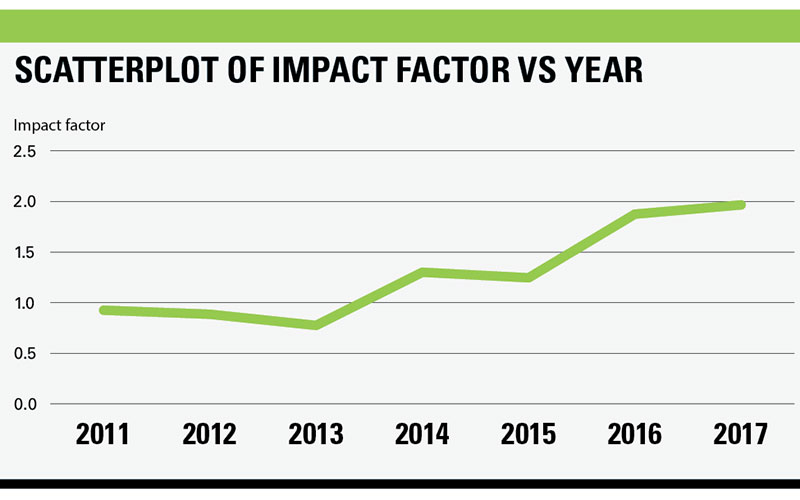The British Journal of Biomedical Science impact factor has increased again, but how is the figure calculated and what does it mean?

One of the ways in which the quality of a journal can be assessed is its impact factor. This number simply divides the number of citations that a journal has accrued during the last few years (that is, the number of times any paper is cited by a different author in their own paper), and the total number of papers published by that journal in that year. So, if no other researcher ever cites an article in a particular journal, its impact factor will be zero. It follows that papers in very influential journals, such as The Lancet, will be cited frequently, and in 2016 The Lancet’s impact factor was 47.83 – very large indeed. That of The British Medical Journal in 2017 was 23.29, whilst the Journal of Clinical Pathology’ has a score of 2.89. The organisers of this scheme – the Institute for Scientific Information – also classifies journals in sections, such as cancer and immunology, ours being “Medical Laboratory Technology”. Other journals in this section include Clinical Chemistry and Annals of Clinical Biochemistry, which have impact factors of 8.01 and 1.98, respectively. Other journals carrying data in common with our journal include the Journal of Clinical Laboratory Analysis, with an impact factor of 1.303, whilst the International Journal of Medical Laboratory Research scores 0.216.
For years, the impact factor of our journal has been around 1.0, sometimes a little above, sometimes a little below. But in the past few years, this has been slowing increasing, and is at present 1.97 (see figure 1, above).
The reason for this is that more of the articles we publish have themselves been cited by other researchers, which in turn means the overall quality of the journal is increasing. Perhaps the primary reason for this is that we moved to submission by website in 2015, enabling the more rapid processing of submissions – a feature highly sought-after by authors. Hopefully, this process will continue. Researchers naturally hope their work will gain wide acceptance, and so will submit to those journals with a good reputation (i.e. a high impact factor, like the Lancet). The increase in impact factor will promote a virtuous cycle, as the better the quality of a journal, the more likely is it to receive quality material, which will be cited, leading to an improvement in the impact factor. Indeed, the average number of a group of patients in cohort studies that we have published rose from 90 in 2016, to 126 in 2017 and to 147 so far this year. Similarly, numbers of subjects in case/control studies was 106/75 in 2016, 174/65 in 2017, and is 199/140 so far this year. Increased numbers (formally described as power) naturally brings increased confidence that the results are likely to be correct, and so increased likelihood of the work being cited.
Whether this trend will continue cannot be predicted, but it is good to know that our journal, and so our vocation, is on the rise.
Andrew Blann, is the Editor of the British Journal of Biomedical Science
